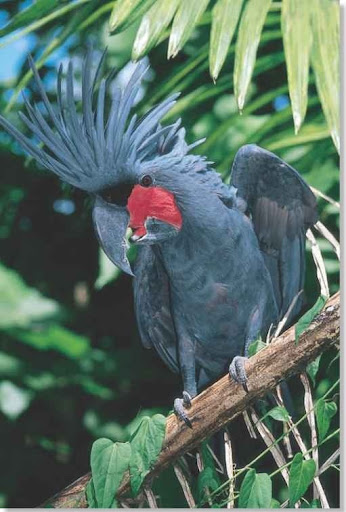

After the chick leaves the nest, both parents provide food and protection for it until it is fully independent. Males also brood the young, but are mainly responsible for finding food. After hatching, chicks are brooded mostly by females. Key Reproductive Features: iteroparous seasonal breeding gonochoric/gonochoristic/dioecious (sexes separate) sexual oviparousĪlthough both parents participate in incubation, females incubate the egg more than males and males spend more of their time foraging for food. Range age at sexual or reproductive maturity (male): 7 to 8 years. Range age at sexual or reproductive maturity (female): 7 to 8 years. Range time to independence: 142 to 152 days. Young birds are estimated to reach sexual maturity at 7 to 8 years old.īreeding interval: Palm cockatoos breed once yearly.īreeding season: The breeding season usually occurs between the months of August and January, but varies with local climate. After this, the young bird will be independent, but will stay relatively close to the parents until the next breeding season, whereupon the parents evict the previous year's young from their territory. They take 100 to 110 days to fledge, the longest period to fledging of any parrot species.Īfter leaving the nest, the young bird is dependent on the parents for at least another 6 weeks because of its inability to fly. The newly hatched young are naked and helpless. Palm cockatoos lay one egg per clutch, which is incubated for 30 to 33 days. The same site is often used year after year. Their nesting holes tend to be about 1 m in depth and 25 to 60 cm in diameter are are lined with a pile of broken twigs at the bottom, upon which the egg rests. Instead they use previously hollowed cavities in large trees, such as palms. Palm cockatoos cannot excavate their own nesting cavities. The mating season varies with local climate, but is usually from August to January. Palm cockatoos are monogamous and stay together for life. Sometimes the male will also bang a stick against a tree while calling out, as a territorial gesture near the nesting sight.
#PALM TREE COCKATOO SKIN#
Before mating the male makes loud whistles and bows several times during which the skin on the face will usually become a deep red.

Other Physical Features: endothermic homoiothermic bilateral symmetryĭuring mating the male and female approach each other with wings extended.

In young birds, the underfeathers are lined with a pale yellow and in very young birds (under 18 months old), the tip of the bill and the eye ring are white. Their cheek skin changes color based on their health or level of stress so when highly stressed the skin will change color to a pink/beige, while when highly excited the skin changes to yellow. Their legs are grey/black with few feathers on their thighs and their red facial markings are their most distinguished characteristic. Their strong mandibles are used for cracking nuts and are larger in males than in females.
#PALM TREE COCKATOO CRACK#
This partly open mouth makes it easier for the birds to hold nuts in their mouth and crack them at the same time. Their beaks never close completely, always revealing a bit of their black-tipped red tongues. Palm cockatoos are almost all black with a 15 cm erectile crest on their head. Wing length is around 35.1 cm, tail length 23.8 cm, bill length 9.1 cm, and tarsus length averages 3.5 cm. They weigh 500 to 1100 g, with females ranging from 500 to 950 g and males ranging from 540 to 1100 g. Palm cockatoos are the largest of all parrots, ranging from 49 to 68 cm in height.


 0 kommentar(er)
0 kommentar(er)
